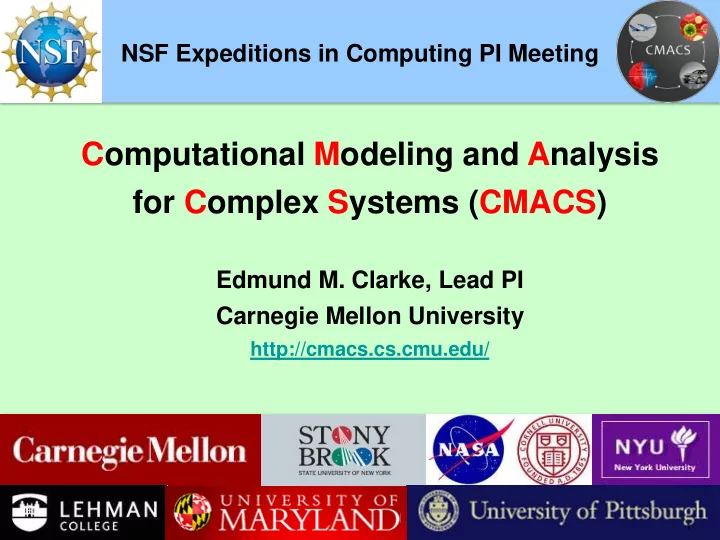

NSF Expeditions in Computing PI Meeting Computational Modeling and Analysis for Complex Systems (CMACS) Edmund M. Clarke, Lead PI Carnegie Mellon University http://cmacs.cs.cmu.edu/ 1
Our Vision To gain fundamental new insights into the emergent behaviors of complex biological and embedded systems through the use of revolutionary , highly scalable , and fully automated modeling and analysis techniques. 2
Our Goals Scientific Model Checking Next-Generation Methodology for Analyzing Complex Systems Abstract Interpretation Societal Tackle Challenge Problems in Systems Biology and Embedded systems Education & Outreach Programs for research and knowledge transfer 3
Model Checking The Model Checking Problem ( Clarke , Emerson, Sifakis „81): Let M be a state-transition graph Let f be a formula of temporal logic e.g., a U b means “ a holds true Until b becomes true” a a a a b Does f hold along all paths that start at initial state of M ? Preprocessor Model Checker Formula f Representation of M True or Counterexample 4
Abstract Interpretation Abstracts the concrete semantics of a system into a simpler abstract semantics Crucial for Analyzing Complex Systems Mature Methodology since [ Cousot & Cousot 1977] Control Abstraction Data Abstraction Widening 5
CMACS Rethink and develop an integration of Model Checking and Abstract Interpretation Driven by the centrality of computational modeling in science & engineering Focus on complex biological and embedded systems Cross-pollinate: same techniques applicable in one domain transfer to the other and beyond 6 6
Challenge of Complex Systems Real-World Biological & Embedded Systems can exhibit any combination of the following features Highly Very High Dimensions Nonlinear Hybrid Safety Critical Behavior Sensitive to (Continuous+ Perturbations Discrete) Stochastic Spatial Behavior Distribution 7
CMACS: Research Team 8
Most Significant Contribution to Date Atrial Fibrillation Challenge Problem : multi- disciplinary, multi-institutional, high-impact research – Increases stroke, heart failure, mortality – Afflicted Americans:12 million by 2050 – 2011 Nature paper on Low-Energy Defibrillation – First automated formal analysis Delta-Reachability : breakthrough theory and techniques for verifying hybrid systems – Scalable model checking for nonlinear hybrid systems – Successfully applied to the Atrial Fibrillation models, and many other realistic biological and cyber-physical systems 9
Control and Termination of Arrhythmias with Low-Energy Defibrillation Low-Energy Defibrillation (LEAP) tested for VF in vitro and for AF in vitro and in vivo (canine hearts). For both AF and VF we found successful defibrillation with LEAP using about 10% of the energy required by the standard 1-shock defibrillation protocol Furthermore, using high-resolution mCT These results appeared we obtained detail vessel distribution of the in Nature 475: 235-239; heart and found a scaling law which was 2011. used to obtain a theory that explains the mechanism behind LEAP. 10 10
First Automated Formal Analysis of Realistic Cardiac Cell Model CMACS researchers from Stony Brook, Cornell & NYU succeeded in carrying out the first automated formal analysis of a realistic cardiac cell model [CAV 2011] Determined parameter ranges that lead to loss of excitability , a precursor to e.g. ventricular fibrillation Multiaffine Hybrid Automaton model of Fenton et al.’s Minimal Cardiac Cell model Such automata commonly used in the analysis of Genetic Regulatory Networks 11
Delta-Reachability http://dreal.cs.cmu.edu Significant breakthrough in unifying logical reasoning and numerical methods [Gao et al. LICS‟12, IJCAR‟12, PhD Thesis, CADE‟13] Theory and tools to perform model checking & parameter synthesis on highly nonlinear hybrid systems Successfully applied on Atrial Filbrillation models and many others Counterexamples from model checking confirmed by experimental simulations . Highly nonlinear model without simplification. Witness trace from Model Checking Depth 24 1500 time units Experimental Simulation (size: 96 ODEs, 240 variables) 12
Workshops on Atrial Fibrillation and Pancreatic Cancer 2011 and 2013: Highly intensive 3-week workshops on Atrial Fribrillation at Lehman College (Bronx, NY), organized by Nancy Griffeth – Develop scientific interest and skills for students from minority-serving institutions – Next workshop in 2014 2010 and 2012: Workshops on signaling pathways and pancreatic cancer Students co-authored in A dvances in Physiology Education 66 students attended; several students went on to PhD programs 13
Other Significant Contributions G. Holzmann & K. Havelund performed formal analysis of complex software in Curiosity Rover P. Cousot has developed liveness analysis of unbounded systems [POPL 2012] and combining algebraic and logical domains [JACM 2012] 14
Other Significant Contributions A. Platzer‟s group have used KeYmaera Theorem Prover to formally verify the Safety of Autonomous Robots [RSS 2013] , Distributed Aircraft Controllers and Surgical Robots [HSCC 2013] KeYmaera KeymaeraD T.T. Wu, H. Gong and E. M. Clarke have identified 12-gene signature for PC survival through Lasso- penalized Cox regression [ J. Bioinformatics & Computational Biology . To appear] 15
Achievements Made Possible by EXP Many breakthroughs are coming from new , cross- institutional , cross-disciplinary collaborations Atrial Fibrillation Pancreatic Cancer Pitt Georgia Tech/RIT CMU Stony Brook (Physics) (Sys Biol) (Computer Sci) (Computer Sci) Fenton Faeder Clarke, Gong Bartocci, Grosu (Biomedical) Miskov-Z Wang, Zuliani Smolka, Glimm Cherry, Climour CMU NYU UPMC UMD (Computer Sci) (Computer Sci) (Cancer Inst) (Public Health) Lotze Clarke, Gao Le Guernic Wu Kong, Liu 16
Future Work: The Next 15 Months and Beyond More detailed, realistic & probing computational models of the biological & embedded systems More scalable formal analysis technology More sophisticated systems and expressive properties Continue our outstanding Education & Outreach program Start planning for follow-up projects. 17
Recommend
More recommend